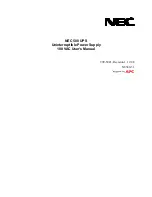
96
017-882-B0-001 Rev. E (06/2018)
3.0 Operation, Continued
3.7 Automatic Performance Test
Automatic Self Test:
An automatic Self Test is periodically performed to verify the state of the batteries and the inverter
circuitry. The automatic test feature has several programmable parameters that determine the frequency and duration of
automatic tests. A running test may be halted manually by pressing the TEST button a second time.
The automatic test feature is on by default. To turn auto-test off, change Test Interval to 0 days in the POWER CONFIG
Menu. Auto-test may be enabled at any time by changing the test interval to any numerical value (excluding “0”). The default
test interval is 30 days.
The test sequence process:
• Begins with a check to verify the batteries are attached and the battery circuit breaker is closed. If the batteries
are discharged or not connected, the power supply does not attempt to operate in inverter mode, preventing a
drop of the load.
• Next, the power supply switches to standby mode for a pre-programmed period. Successful completion of a test
sequence indicates the unit is operating normally in standby mode, the battery voltage did not drop below a preset
threshold and the output was stable throughout the test. Failure of test is indicated by a Self Test Fail alarm, which
can be cleared by subsequently running a successful test for at least one minute.
In addition to automatic testing, the operator can manually initiate a Self Test. A running test may be halted at any time by
pressing the Self Test switch on the front panel (below the OUTPUT and ALARM LEDS on the Inverter Module) or from the
PWR CONFIG menu. The status monitoring card allows a Self Test to be initiated via the webpage as well.
Test Inhibit:
The Test Inhibit command prevents an automatic test scheduled to occur in the next week. This command is
useful if periodic maintenance of the power supply is scheduled close to the next scheduled automatic test.
Use this feature when inclement weather might cause a utility failure. The Test Inhibit command affects an automatic test
scheduled to run in the next seven days. Multiple issues of the Test Inhibit command result in the deferral of the next automatic
test until at least seven days after the last request. This command has no effect if an automatic test is not scheduled to take
place in the next week. Starting a test manually overrides the Test Inhibit command.
















































